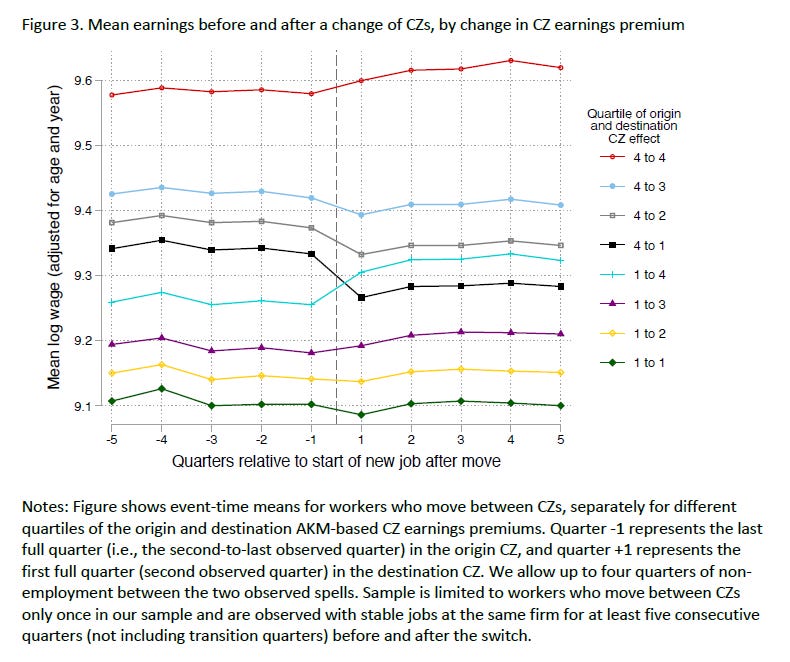Location, Location, Location
Location, Location, Location
Authors: David Card, Jesse Rothstein, Moises Yi
Abstract: We use data from the Longitudinal Employer-Household Dynamics program to study the causal effects of location on earnings. Starting from a model with employer and employee fixed effects, we estimate the average earnings premiums associated with jobs in different commuting zones (CZs) and different CZ-industry pairs. About half of the variation in mean wages across CZs is attributable to differences in worker ability (as measured by their fixed effects); the other half is attributable to place effects. We show that the place effects from a richly specified cross sectional wage model overstate the causal effects of place (due to unobserved worker ability), while those from a model that simply adds person fixed effects understate the causal effects (due to unobserved heterogeneity in the premiums paid by different firms in the same CZ). Local industry agglomerations are associated with higher wages, but overall differences in industry composition and in CZ-specific returns to industries explain only a small fraction of average place effects. Estimating separate place effects for college and non-college workers, we find that the college wage gap is bigger in larger and higher-wage places, but that two-thirds of this variation is attributable to differences in the relative skills of the two groups in different places. Most of the remaining variation reflects the enhanced sorting of more educated workers to higher-paying industries in larger and higher-wage CZs. Finally, we find that local housing costs at least fully offset local pay premiums, implying that workers who move to larger CZs have no higher net-of-housing consumption.
Seminar Notes
Objective
To understand to what extent differences in unobserved skills is driving differences in labor market outcomes across place.
Do the causal effects of place reflect industry clusters?
How do these effects vary over the education of workers?
Importance
Some work in Europe, but this is the first paper to do movers design to study location wage differences for a big sample in the US
Background
There are big differences in labor market outcomes across locations.
Standard deviation of mean log wage=0.141 across CZs
Data & Key Variables
ACS - stylized facts on CZs and wages
LEHD 2010Q1-2018Q4. Age 22-62, earn>=3800, 1 employer, observe CZ & industry
Drop if <8 quarters of earnings, drop first and last quarters of employment spell
Subsample of employees with 5 consecutive quarters at one firm followed by 5 consecutive quarters at another
Methodology
Movers design - follow workers when they move from one place to another to see if their wages change
AKM 2-way fixed effects: person effects (portable skills) + firm effects (firm pay policies).
Locations premium=aggregated firm premiums in CZ
Exogenous mobility across firms does not equal exogenous mobility across place.
Movers from small towns to big cities tend to be the best workers from those small towns. Vice-versa for movers from cities to towns
Results
Place effects account for ~1/3 of the variation in earnings across CZs. The other 2/3 comes from variation in worker quality (sorting & unobserved skills)
Are some places better paying just because of the industry mix? Not really
Do bigger cities pay more because they are big? 2/3 of the effect from the people. High-skill people are sorting into bigger places
Returns to education: Two AKMs for two education groups. 88% of the gap in returns to education is driven by sorting
Housing costs (more than) fully offset place-based earnings premiums

